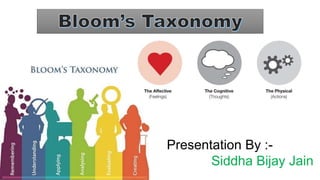
Bloom's Taxonomy
- 1. Presentation By :- Siddha Bijay Jain
- 3. What is taxonomy ? 1. A classification into ordered categories 2. The science or technique of classification
- 4. • Set of three hierarchical models Cognitive Affective Psychomotor • Used to classify educational learning objectives • A logical framework for teaching and learning goals.
- 5. Cognitive :- Mental skills (Knowledge) Affective :- Growth in feelings or emotional areas (Attitude or Self) Psychomotor :- Manual or Physical skills
- 6. • Published in 1956 at the University of Chicago • Named after Benjamin Bloom who chaired the committee of educators that devised the taxonomy
- 9. Remember Remembering or recognizing facts, terms , basic concepts without necessarily understanding what they mean. Characteristics Behavioral Learning Outcome Ability to recall appropriate, learned information on command. Cognitive Learning Outcome Lowest level of learning outcomes.
- 10. Understand Understanding of facts and ideas Characteristics Behavioral Learning Outcome Being able to translate materials from one form or format to another by explaining or summarizing and predicting consequences or effects. Cognitive Learning Outcome Represents the lowest level of understanding and interpretation of rote factual information
- 11. Apply Applying involves using acquired knowledge for solving problems in new situations Characteristics Behavioral Learning Outcome Applying learned material such as rules, methods, concepts, principles, laws, and theories. Cognitive Learning Outcome Learning outcomes demonstrate a higher level of understanding of the mechanics of employing information to a purpose than comprehension.
- 12. Analysing Involves examining and breaking information into component parts Identifying motives or causes Determining how the parts relate to one another Characteristics Behavioral Learning Outcome The student is able to develop multiple conclusions concerning the motives, causes, inferences and generalizations Cognitive Learning Outcome Learning outcomes involve a comprehension and understanding of the content and structure of the material
- 13. Evaluating Evaluating involves Presenting and defending opinions by making judgments about • Information • The validity of ideas • Quality of work based on a set of criteria Characteristics Behavioral Learning Outcome Student is able to produce an end product that fulfills a given purpose rather than being right/wrong. Cognitive Learning Outcome Learning outcomes highest because it contains all other categories and includes value judgments based on clearly defined criteria.
- 14. Create Using new and creative applications of prior knowledge and skills Characteristics Behavioral Learning Outcome The student’s ability to produce a new or original end product. Cognitive Learning Outcome Learning outcomes emphasize creativity and the creation of unique patterns or structures.
- 16. The way people react emotionally and their ability to feel other living things' pain or joy. Targets the awareness and growth in attitudes, emotion, and feelings.
- 18. Receiving Involves passively paying attention and being aware of the existence of certain ideas, material, or phenomena. Keywords: Asks, chooses, describes, follows, gives, holds, identifies, locates, names, points to, selects, sits, erects, replies
- 19. Responding Actively participating in the learning process. You are not only aware of a stimulus, but reacting to it in some way. Keywords: Answers, assists, aids, complies, conforms, discusses, greets, helps, labels, performs, practices, presents, reads, recites, reports, selects, tells, writes.
- 20. Valuing Ability to see the value or worth of something and express it. Keywords: Completes, demonstrates, differentiates, explains, follows, forms, initiates, invites, joins, justifies, proposes, reads, reports, selects, shares, studies, works
- 21. Organizing Putting together different values, information, and ideas then relating them to already held beliefs to create your own unique value system. Keywords: Adheres, alters, arranges, combines, compares, completes, defends, explains, formulates, generalizes, identifies, integrates, modifies, orders, organizes, prepares, relates,
- 22. Characterizing Acting consistently in accordance with the values you have internalized. Keywords: Acts, discriminâtes, displays, influences, listens, modifies, performs, practices, proposes, qualifies, questions, révises, serves, solves, verifies.
- 25. Perception The ability to use sensory cues to guide motor activity. This ranges from sensory stimulation, through cue selection, to translation. Example : Estimate where a ball will land after it is thrown and then moving to the correct location to catch the ball
- 26. The early stages in learning a complex skill that includes imitation and trial and error. Guided Response Examples: Performs a mathematical equation as demonstrated. Follows instructions to build a model
- 27. Readiness to act. These sets are dispositions that predetermine a person's response to different situations Set Examples: Knows and acts upon a sequence of steps in a manufacturing process.
- 28. Mechanism This is the intermediate stage in learning a complex skill. Learned responses have become habitual and the movements can be performed with some confidence and proficiency. Examples:
- 29. Adaptation Skills are well developed and the individual can modify movement patterns to fit special requirements. Examples: Responds effectively to unexpected experiences.
- 30. Origination Creating new movement patterns to fit a particular situation or specific problem Examples: Constructs a new theory. Develops a new and comprehensive training programming
Editor's Notes
- 2. It would help researchers and educators understand the fundamental ways in which people acquire and develop new knowledge, skills, and understandings Cognitive: Affective: Sensory:
